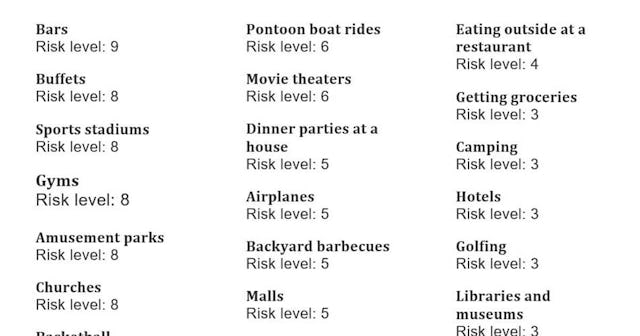Health Experts Rank Activities Based On Coronavirus Risk

Four public health experts assess the risk for 36 different activities amid the coronavirus pandemic
As states move through the phases of reopening the economy and American citizens consider going back to some of their pre-pandemic activities, there’s a lot of questions about what might be relatively safe and what might make sense to avoid altogether for the time being. Everyone has opinions and trying to sort it all out is an anxiety-inducing headache. That’s why we’re glad for some guidance from public health experts on just how risky certain activities are now that we’re navigating a coronavirus world.
The information is presented by MassLive and comes from the collective opinions of four Michigan public health experts.
The experts weighing in definitely have the credentials to speak with authority on the issue. They include: Dr. Matthew Sims, Beaumont Health director of infectious disease research; Dr. Dennis Cunningham, McLaren Health Care medical director for infection prevention; Dr. Mimi Emig, retired infectious disease specialist with Spectrum Health; and Dr. Nasir Husain, Henry Ford Macomb medical director for infection prevention.
The activities the group of doctors ranked by level of risk from 1-10 (10 being riskiest) include going to the gym, camping, visiting a hair salon, a trip to the beach, and dozens more. They elaborate on each and note that with so many activities, it will all depend on certain factors.
For example: the risk level of going to the beach obviously depends on how crowded that beach is. “But therein lies the problem,” Emig said. It’s hard for beaches to regulate how many people come to spend time in the sand and it’s almost impossible to enforce precautions in that environment. Husain suggests going at off-peak times to minimize risk.
Some activities are just going to be a high level of danger no matter what, and that includes bars, which are ranked at a level 9 out of 10. “After a couple of drinks, they’re starting to feel a little more invincible,” Husain said. “And that’s when the trouble starts.” Sims adds, “I’d probably give bars a 10. I’m really worried about bars.”
Events like concerts are similarly risky, and sports stadiums aren’t any better. The experts note that both activities involve cheering, yelling, or singing in close proximity to others — all of which can more easily emit the virus into the air.
The experts all seem to agree that one summer stalwart activity for kids is among the riskiest — public pools. “There’s no way to make it safe,” Emig said. “How are you going to wear your mask in the pool?” There are also still question marks about whether the virus can spread in that environment. “We don’t have good data to show how the virus would behave in a pool,” Husain said. “Pool water does have chlorine in it, but I don’t think it’s high enough to be very effective in completely reducing risk to zero.”
As far as relatively low risk things to do? Playing tennis, getting takeout, going for a walk, run, or bike ride with others, and visits to libraries and museums are all ranked a risk level 3 or less.
The information coming out about coronavirus is ever-evolving as scientists and medical professionals learn more about its transmissibility. It’s still recommended to socially distance and wear masks in public as much as possible, but having guidelines from those in the know about what activities might be safe is helpful as we learn to live in this new pandemic world.